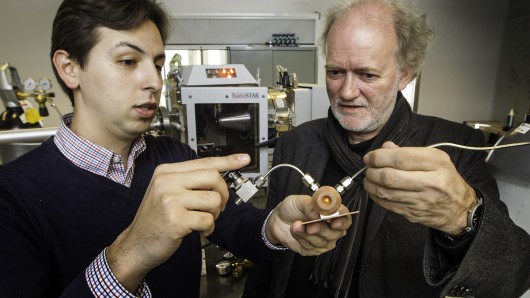
Leander Michels (left) and Prof. Jon Otto Fossum hold a chamber they use to study clay samples (Photo: Per Harald Olsen, NTNU)
In order to minimize the amount of human-produced greenhouse gases entering the atmosphere, numerous scientists have studied materials that could be used to capture excess carbon dioxide at one of its main sources – industrial smokestacks. Such substances have included metal-organic framework materials, ionic liquids, and even a sea urchin-inspired material. Unfortunately, however, not everything that's been suggested is inexpensive or easy to produce. That said, Norwegian researchers now believe that humble clay could do the job just fine.
Led by the Norwegian University of Science and Technology's Prof. Jon Otto Fossum and PhD candidate Leander Michels, the scientists discovered that clay minerals – particularly smectite – possess all the qualities needed for good CO2 capture. These include a large surface area, decent adsorption capability, the ability to selectively trap CO2 molecules before filling up on other types of molecules, low energy requirements, and reusability.
Smectite starts by swelling (and thus increasing its surface area) when exposed to moisture, such as that which is present in flue gases. From there, CO2 molecules in those gases bond with ions in the surface of the clay.
One type of smectite in particular, lithium-fluorohectorite, is able to hold onto those trapped molecules at ambient pressure, at temperatures up to 35 ºC (95 ºF). Once it's heated beyond that point, it releases them – this could allow for controlled repurposing of the CO2, and for reuse of the clay smokestack filter.
The scientists actually used synthetic smectite in their study, which they claim can be inexpensive to manufacture.
"Our experiments show that this kind of smectite can capture and retain as much CO2 as other materials that have been studied for this purpose," said Fossum. He added, however, that the research is still in its early stages, and it will be some time before such filters could be in use.
A paper on the research was recently published in the journal Scientific Reports.
Source: Gemini
copyright © Gizmag 2003 - 2015